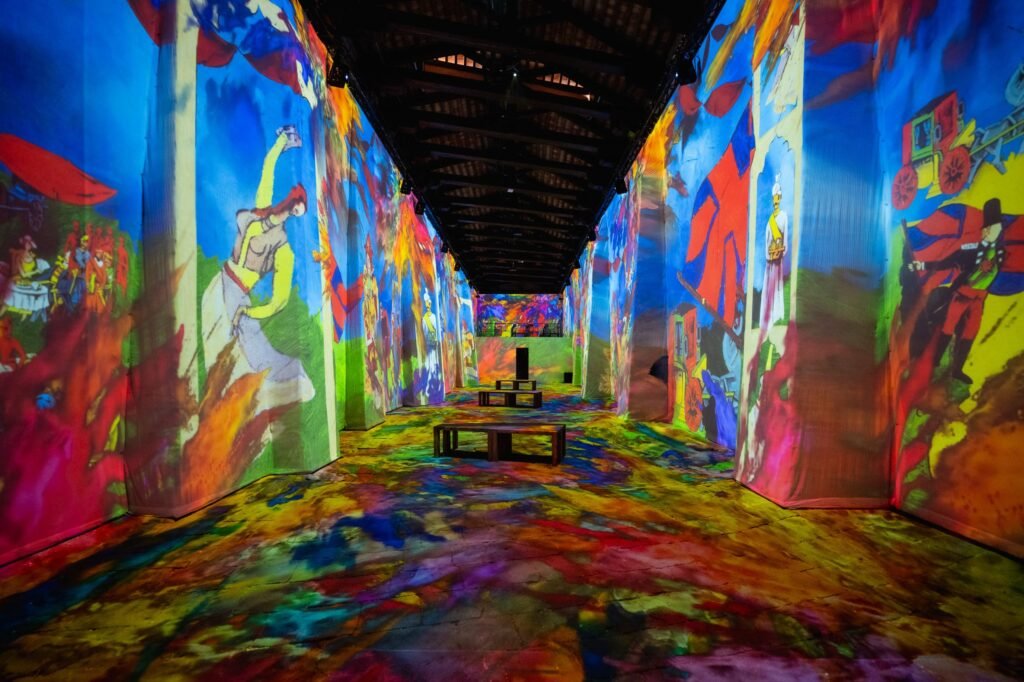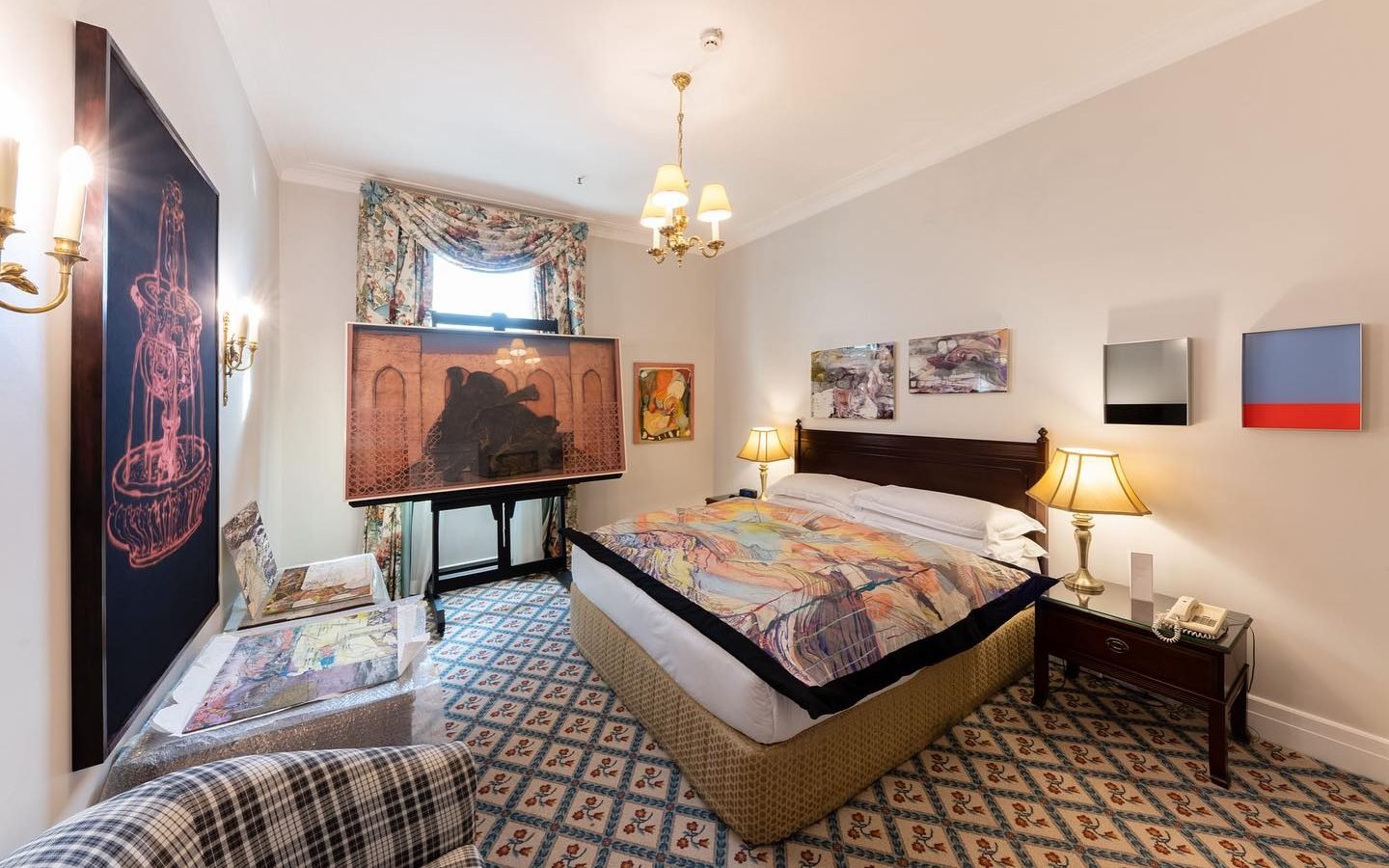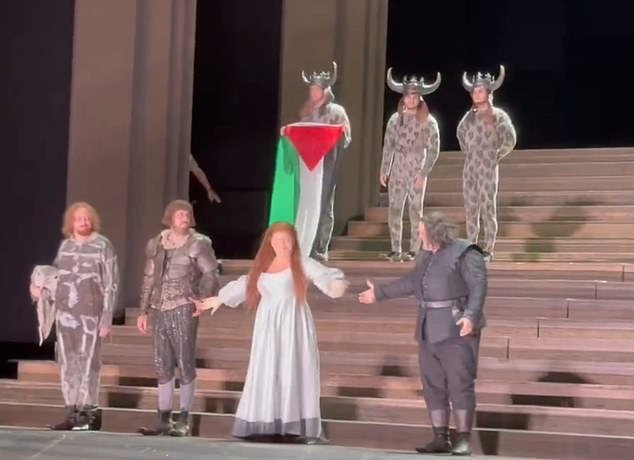One of the more unusual collateral exhibitions at this year’s Venice Biennale, The Rooted Nomad: M.F. Husain, might be a test case for what immersive art can and can’t do
It’s easy to criticise the genre of ‘immersive’ art: it’s all spectacle, not ‘proper’ art; all medium, no message; it’s just a form of commercial entertainment. And yet, many of the most popular and recent immersive shows are based on the work of the historical masters of (mostly Western) modernist art: Van Gogh, Monet, Klimt, Kahlo, Picasso. They are artists whose styles are instantly recognisable, and whose work audiences flock to see ‘remade’ through the technique that’s native to the immersive genre: largescale, high-definition wraparound animated digital-video projection, often accompanied by music, ambient sound and voiceover narrative. Rather than see the authentic artwork – static small, silent framed canvases hung on walls – immersive audiences are happy to see painterly styles chopped, sampled, edited and made kinetic and durational: animate rather than in-. Which provokes the question – do we really care anymore about an original painting and the history from which it evolved, or about giving it the kind of attention it might have once attracted? What happens to art history when it gets remade into an experience?
One of the more unusual collateral exhibitions at this year’s Venice Biennale, The Rooted Nomad: M.F. Husain, might be a test case for what immersive art can and can’t do in this type of situation. Organised by the Kiran Nadar Museum of Art (KNMA) and installed in the rough, cavernous spaces of the Magazzini del Sale, The Rooted Nomad is a two-part exhibition based on the work of celebrated postwar Indian modernist Maqbool Fida Husain (1915–2011). The first half is a compact but impressive selection of Husain’s paintings, drawings, prints and wooden painted reliefs, alongside photographs of the artist documenting his daily life, from the 1940s through the 1990s. The first space presents a tightly selected summary of Husain’s early claiming of Western modernist precedents, drawing from Cubism to Expressionism. Husain was a founding member of Mumbai’s Progressive Artists’ Group, formed in 1947, the year of Indian independence, and his work typifies the group’s desire to bring modernism into dialogue with Indian art, positioning itself in opposition to the revivalist traditionalism of the Bengal School movement then influential. It was a moment in which tradition, modernity and nationhood were all being vigorously debated, and it came to define Husain’s work in the following decades. For Husain this meant fusing heterogeneous modernist styles with a popular iconography that celebrated and idealised everyday rural and urban Indian life (farmers with their oxen, peasant women at work), while also drawing on the figures of Indian religious traditions, particularly the figures of Hindu deities such as the elephant-headed Ganesh.

Beyond the traditional exhibition, in a rough brick vaulted space (the Magazzini are historic Venetian warehouses), is an all-surrounding floor-to-ceiling immersive video installation. The 40-minute sequence spins together animated renditions of elements drawn from his paintings and drawings with lyrical graphic sequences, in a romanticised evocation of the artist’s long life and artistic journey: from his early fame as a sort of artistic avatar of the newly independent India, to his later life lived abroad, a result of the political persecution the Muslim-born artist faced after 1996, when works that had been made during the 1970s, depicting interpretations of naked Hindu goddesses, were republished, becoming lightning rods for the religious outrage for Hindu nationalists. What followed were years of harassment and legal actions against Husain, who eventually left India in 2006, never to return.
The Rooted Nomad keeps away from the thorny politics of these later controversies – none of the controversial works are represented, and the chronology ends with the remarkable canvas Karbala (1990), a dynamic interpretation of the 680 battle in which Husayn ibn Ali, grandson of the prophet Muhammad, fell against the forces of the caliph Yazid. A whirl of white horses clashing with fierce black horses, it pointedly only represents Husayn by his turban and a stylised version of his name in Arabic.

The immersive section similarly only hints at Husain’s later troubles, representing his relocation to London and then finally Qatar as an aspect of Husain’s benign artistic cosmopolitanism, symbolised by the recurring motif of a child’s paper airplane caught by the breeze. Politics aside, the contrast between the two parts makes one acutely aware of the value of presenting historical art on its own terms, and the awkward limitations of turning it into the form of time-based narrative art. Given that the immersive was created by Visioni, the Italian media-studio responsible for the immersive crowd-pullers based on Van Gogh et al, it’s an expertly handled experience, with some breathtaking moments. Sequences in which the whole space is occupied by cascades of leaf-fall or flocks of birds, or where the walls and floor, covered in newspaper pages, appear to catch fire, linger in the mind.
While such imagery isn’t perfectly aligned with Husain’s own painterly style, what’s particularly interesting about him is that he wasn’t above shifting his style around, from modernist seriousness to a more playful and popular illustrative style and everyday narrative content. There’s a tension, then, between these slick and sophisticated digital composites and CGI renders that fade and flutter into view, and Husain’s ‘serious’ work: the dense, earthy colours and robust lines, the often monumental vision of the human figure, and a painterly texture and subtlety that’s hard to reproduce in pixels. But the immersive readily and easily absorbs and reworks the more populist aspects of Husain’s art: the cartoonish social satires of Indian history and the witty line-drawings of everyday life, their idiom more newspaper cartoon than post-Cubism. Unlike the more canonical masters of modernism – whose style and ‘greatest hits’ can more easily be harnessed to the all-over immersive effect – Husain had a broader bandwidth ranging across ‘high’ and ‘popular’ art. A long life and, to be honest, the artist’s openness to making work for where the money was, makes his work less easily digestible for the new genre that is the ‘immersive’ exhibition. He’s not a pure ‘high’ artist with a single, canonical style; rather, an artist who in his formative years in 1930s Mumbai made a crust from painting cinema hoardings and knew something about showmanship and how to please an audience. It’s only a pity that he isn’t around to make the immersives himself.
The Rooted Nomad: M.F. Husain, at Magazzini del Sale, Dorsoduro, Venice, through 24 November






